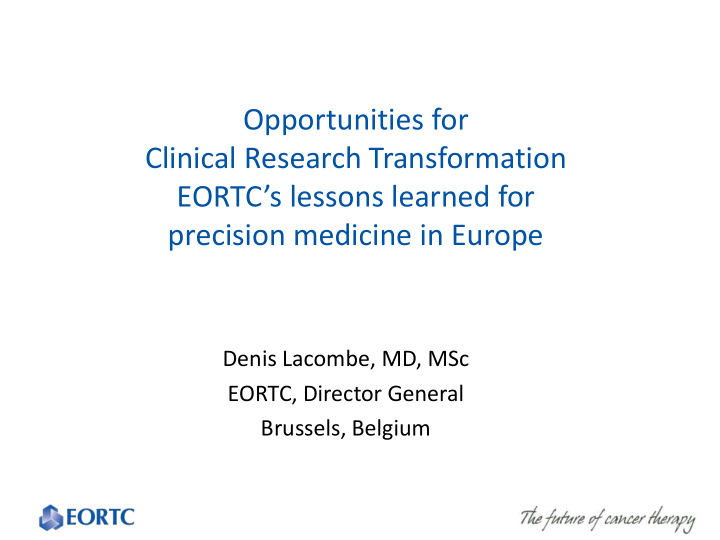



Opportunities for Clinical Research Transformation EORTC’s lessons learned for precision medicine in Europe Denis Lacombe, MD, MSc EORTC, Director General Brussels, Belgium
EORTC by the numbers (2016)
Recurrent pivotal questions • Is the classical phase I, II, II process still adequate? • How to access efficiently sub- group of molecularly defined patients? • What are the pre-analytical requirements for biological samples, handling? • What are the adequate steps for analytical and clinical validation of a biomarker and related assay? • How to qualify cut-off values for decision process? • What is the impact on clinical trial designs and optimal assessment of clinical utility? • How the process of drug registration and access will evolve? • How will new treatments be valued at the light on their true benefit in real life?
Towards a data driven healthcare from “omics” to economics Faster access to (cost)effective care Treatment Biomarker guideline analytical and development Regulatory clinical pathway / validation Market access supported by Innovative agile trial designs / licensing Trial access Business risk reduction
The changing clinical research pathway From trials “designed to learn” to real life situation Population-based Early clinical trials (R&D) studies • Biology / imaging driven • Real world data Pivotal trials • Integrated TR • Quality of life • Highly targeted • Screening platforms • Health economics • Large differences • Collection of high quality • HTA data from various sources • Pragmatic trials Burock et al. Eur.J.Cancer (2013), http://dx.doi.org/10.1016/j.ejca,2013.05.016
The 2 major challenges for precision medicine • Drug development clinical research is currently not patient centered Drug centered based on non representative/highly selected patient population The need: Protocols seeking patients patient seeking protocols • Sub-optimal anticipation of real life questions: • combinations, sequence, duration, QoL , long term outcome and toxicity … The need: build on applied (often independent) clinical research Do our systems function correctly: Why do HTA bodies and payers would take decision based on drug development research when it should happen based on applied clinical research?
Solution to challenge 1: collaborative platform Academia Molecular Screening Platform Standard treatment (no open trial) 1 st line trial Standard treatment Industry 2 nd line trial Third line First line cooperation 3 rd line trial First line Second line Standard treatment (no open trial) A prospective and longitudinal clinically annoted biobank
Solution to challenge 1: The principle of dual longitudinal continuity Patient/disease evolution Drug/TRT3 Drug/TRT2 Drug/TRT1 Drug development process 9
Solution to challenge 2: from R&D to real life Early Drug Development Market access Real Life Use Manufacturer 1 Drug A Manufacturer 2 Drug B Manufacturer 3 Drug C Combos & Integration with existing treatments Regulators and payers Basic researcher Drug developers
Conclusions A major transformation of clinical research building on the strengths and complementarity of stakeholders working alongside new business models must be tackled to make the above possible. The proposed continued solutions should happen through new collaborative, complementary and interactive sequences taking into account the interests and needs of all stakeholders
How could it happen? Non commercial sector Commercial sector Non commercial sector Drug development clinical research Therapeutic optimisation applied clinical research Triage and access Real Life Long term monitoring partnership regulators Partnership HTA/payers Independent platforms Partnership registries HTA/payers Partnerships commercial sector
Recommend
More recommend